There are only four days to go before Pope Francis arrives in Seoul.

In honor of the pontiff’s first visit to Korea, the Korean Culture and Information Service (KOCIS), part of the Ministry of Culture, Sports and Tourism and publisher of Korea.net, held a guided tour for journalists assigned to the nation, including representatives from Agence France-Presse (AFP), Al Jazeera and Xinhua.
During the two-day program, the journalists had the chance to trace in advance some of the sites put on the pope’s itinerary for his upcoming five-day trip to Korea.
On August 6, they visited the Seosomun Martyrs’ Shrine, one of the official execution grounds in Seoul where many Catholics were martyred during the Joseon Dynasty (1392-1910). The pontiff is scheduled to visit the shrine on August 16, the third day of his visit, to pay tribute to the martyrs, just prior to holding a ceremony to beatify Paul Yun Ji-chung and 123 of his companions, all declared “venerable” on February 7 this year. The beatification ceremony will take place in Gwanghwamun Square in the heart of Seoul on August 16.
According to the itinerary, the pope will arrive at the Seosomun Martyrs’ Shrine at about 9:00 a.m. on August 16, departing from the Vatican Embassy in Seoul. He will then be carried in an open car to Gwanghwamun Square to conduct the beatification ceremony. The shrine is a historic holy place of martyrdom, steeped with the blood, sweat and tears of many Catholics who suffered in prison, were tortured and executed, simply because of their beliefs.
The pope will trace the route back to the holy shrine where the historic martyrdoms took place, leading all the way to the square, where Catholics were captured and incarcerated.
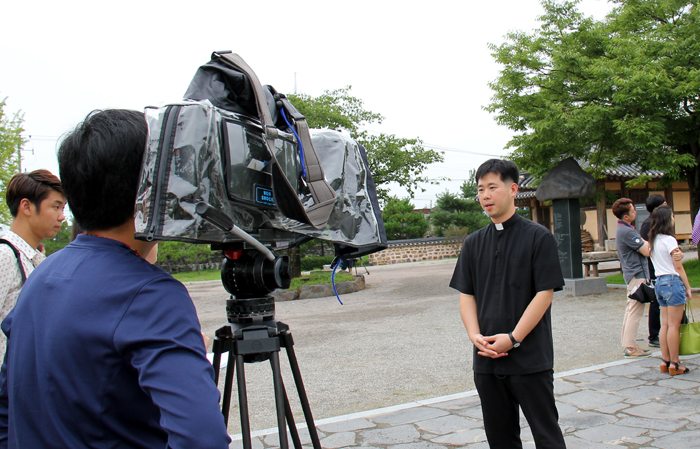
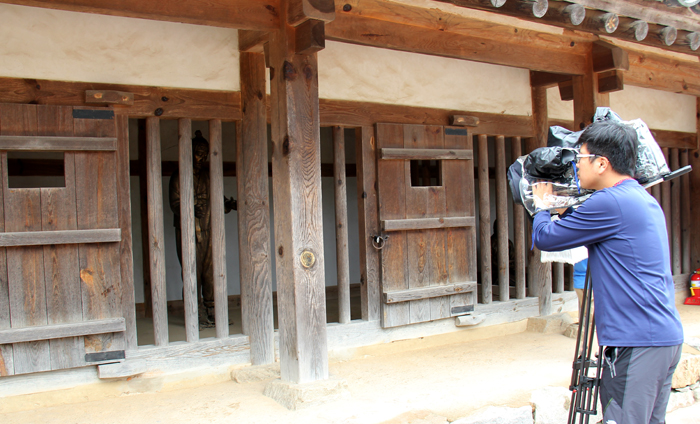
Father Joseph Lee Joon-seong of the Yakhyeon Catholic Church, the first Catholic church in Korea, located in Joongrim-dong, central Seoul, is set to greet the visiting pontiff at the entrance to the Seosomun Martyrs’ Shrine, the point from which the motorcade carrying the pope will depart.
“It is such an honor for me to meet the pope in person, that close up,” said the priest. “I expect that he will give us direction and new vision into how we can continue to live, as we live in a world where the ideology of economic growth and the pursuit of human values collide with each other,” he added.
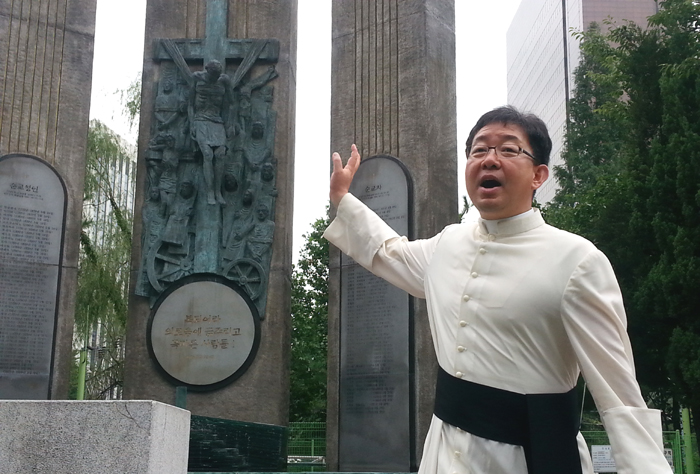
The group of journalists was taken to the Myeongdong Cathedral, the final stop for the pope, where he will celebrate a “Mass for Peace and Reconciliation” on August 18. In attendance with former WWII sex slaves and Catholics from North Korea, the pope will send a message of peace to the world during the Mass.
The journalists then continued to follow a Catholic pilgrimage route across Seoul, covering the Yakhyeon Catholic Church and the Danggogae Martyrs’ Shrine, through to the Jeoldusan Martyrs’ Shrine and the Saenamteo Martyrs’ Shrine.
Among the various sites, the Danggogae Martyrs’ Shrine gives off a cozy and warm atmosphere, as if being in one's mother’s arms. The journalists happened to run into Shim Soon-hwa Catherine while there, a painter who designed part of the holy site. She prepared something special for the pontiff. It is a painting, titled “The Virgin Mary of Peace.” It depicts the Virgin Mary dressed in traditional Korean Hanbok attire, including the traditional binyeo hairpin, as she holds the little baby Jesus, surrounded by cherubs and flowers. The painting includes children of the world sitting at the Virgin Mary's feet, representing Africa, South America, the Middle East and the Koreas, all groups of people that need “peace,” the artist said.
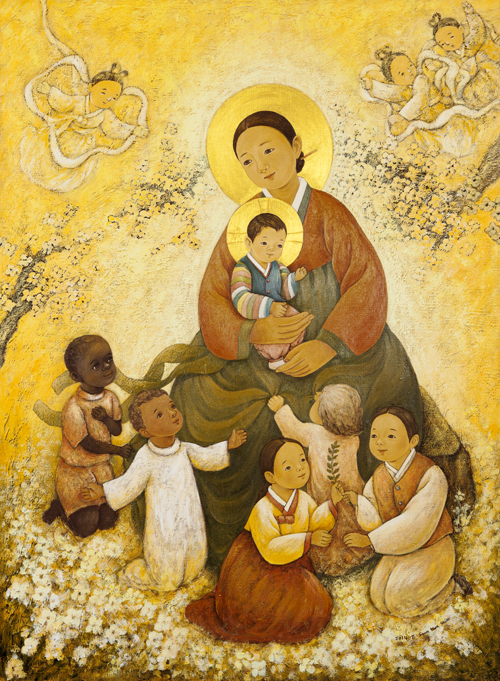
Another of Shim’s work, “The Virgin and Child of Korea,” painted in 2003, will be engraved on commemorative medals designed by the Vatican to mark the pope’s visit to Korea.
“I painted ‘The Virgin Mary of Peace’ always keeping in mind a motif of ‘peace,’” the artist said. “I did it hoping that the Virgin Mary would bring peace to the world, as well as to Korea, as the pope has always wished,” she added.
The next day on August 7, the group of correspondents was bussed to Dangjin, Chungcheongnam-do, home to another historic holy site, the Shrine of Solmoe. The Solmoe shrine is the birth place of St. Andrew Kim Dae-geon, the first Korean Catholic priest. Solmoe means, “A forest of pine trees that makes a little hill.” Four-generations of this particular Kim clan, including his great-grandfather, Pius Kim Jin-hu, his uncle, Andrew Kim Jong-han, and his father, Ignatius Kim Je-jun, were all martyrs and all lived here.
The pope will meet a group of youths on August 15 for dinner, participants in the sixth Asian Youth Day, the biggest youth-oriented Catholic event, that will take place from August 10 to 17 at the Solmoe shrine.
Then the press group moved on to explore another holy site in the region, the Haemi Martyrdom Holy Grounds, in Seosan. From 1790 to 1880, thousands of Catholic believers were executed here as state offenders. The journalists found that the martyrs had died in such cruel ways as being tortured, beheaded, drowned and stoned to death.
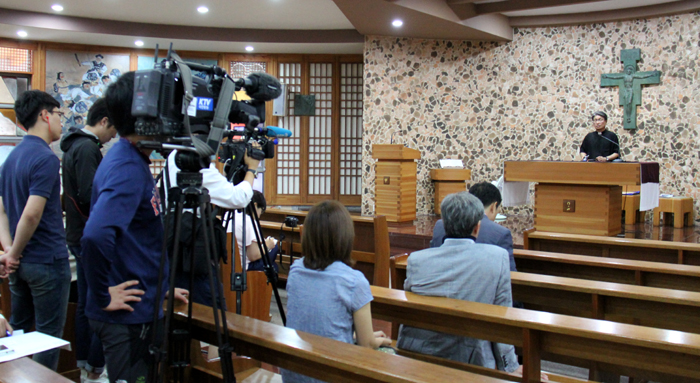
At the holy site on August 17, the pope will meet with representatives from a group of Asian episcopates and pay his respects to the martyrs who were buried here. He will then move to the Haemi Fortress where he will celebrate a closing Mass at the Asian Youth Day festival.
“The pope’s visit means a lot to Korea, as our nation is one of the few divided countries in the world,” said Father Paik Sung-soo Simon of the Haemi Martyrdom Holy Grounds. “’Peace’ and ‘reconciliation,’ two factors that the pope has strongly emphasized, are what Korea needs the most. I hope that the pope will bring peace to our nation,” he continued.
By Sohn JiAe, Lee Seung-ah
Korea.net Staff Writers
jiae5853@korea.kr

Part of Korea's foreign press corps shoots in the Yakhyeon Catholic Church, the first-ever Western-style cathedral in Korea, on August 6.
In honor of the pontiff’s first visit to Korea, the Korean Culture and Information Service (KOCIS), part of the Ministry of Culture, Sports and Tourism and publisher of Korea.net, held a guided tour for journalists assigned to the nation, including representatives from Agence France-Presse (AFP), Al Jazeera and Xinhua.
During the two-day program, the journalists had the chance to trace in advance some of the sites put on the pope’s itinerary for his upcoming five-day trip to Korea.
On August 6, they visited the Seosomun Martyrs’ Shrine, one of the official execution grounds in Seoul where many Catholics were martyred during the Joseon Dynasty (1392-1910). The pontiff is scheduled to visit the shrine on August 16, the third day of his visit, to pay tribute to the martyrs, just prior to holding a ceremony to beatify Paul Yun Ji-chung and 123 of his companions, all declared “venerable” on February 7 this year. The beatification ceremony will take place in Gwanghwamun Square in the heart of Seoul on August 16.
According to the itinerary, the pope will arrive at the Seosomun Martyrs’ Shrine at about 9:00 a.m. on August 16, departing from the Vatican Embassy in Seoul. He will then be carried in an open car to Gwanghwamun Square to conduct the beatification ceremony. The shrine is a historic holy place of martyrdom, steeped with the blood, sweat and tears of many Catholics who suffered in prison, were tortured and executed, simply because of their beliefs.
The pope will trace the route back to the holy shrine where the historic martyrdoms took place, leading all the way to the square, where Catholics were captured and incarcerated.


Members of Korea's foreign press corps get footage of the Haemi Fortress in Seosan, Chungcheongnam-do (South Chungcheong Province), on August 7.
Father Joseph Lee Joon-seong of the Yakhyeon Catholic Church, the first Catholic church in Korea, located in Joongrim-dong, central Seoul, is set to greet the visiting pontiff at the entrance to the Seosomun Martyrs’ Shrine, the point from which the motorcade carrying the pope will depart.
“It is such an honor for me to meet the pope in person, that close up,” said the priest. “I expect that he will give us direction and new vision into how we can continue to live, as we live in a world where the ideology of economic growth and the pursuit of human values collide with each other,” he added.

Father Joseph Lee Joon-seong of the Yakhyeon Catholic Church stands in front of the 15 meter Hyunyang Tower, dedicated to Catholic martyrs, at the Seosomun Martyrs’ Shrine in central Seoul.
The group of journalists was taken to the Myeongdong Cathedral, the final stop for the pope, where he will celebrate a “Mass for Peace and Reconciliation” on August 18. In attendance with former WWII sex slaves and Catholics from North Korea, the pope will send a message of peace to the world during the Mass.
The journalists then continued to follow a Catholic pilgrimage route across Seoul, covering the Yakhyeon Catholic Church and the Danggogae Martyrs’ Shrine, through to the Jeoldusan Martyrs’ Shrine and the Saenamteo Martyrs’ Shrine.
Among the various sites, the Danggogae Martyrs’ Shrine gives off a cozy and warm atmosphere, as if being in one's mother’s arms. The journalists happened to run into Shim Soon-hwa Catherine while there, a painter who designed part of the holy site. She prepared something special for the pontiff. It is a painting, titled “The Virgin Mary of Peace.” It depicts the Virgin Mary dressed in traditional Korean Hanbok attire, including the traditional binyeo hairpin, as she holds the little baby Jesus, surrounded by cherubs and flowers. The painting includes children of the world sitting at the Virgin Mary's feet, representing Africa, South America, the Middle East and the Koreas, all groups of people that need “peace,” the artist said.

Painter Shim Soon-hwa Catherine’s 'The Virgin Mary of Peace' is made in honor of Pope Francis’ visit to Korea.
Another of Shim’s work, “The Virgin and Child of Korea,” painted in 2003, will be engraved on commemorative medals designed by the Vatican to mark the pope’s visit to Korea.
“I painted ‘The Virgin Mary of Peace’ always keeping in mind a motif of ‘peace,’” the artist said. “I did it hoping that the Virgin Mary would bring peace to the world, as well as to Korea, as the pope has always wished,” she added.
The next day on August 7, the group of correspondents was bussed to Dangjin, Chungcheongnam-do, home to another historic holy site, the Shrine of Solmoe. The Solmoe shrine is the birth place of St. Andrew Kim Dae-geon, the first Korean Catholic priest. Solmoe means, “A forest of pine trees that makes a little hill.” Four-generations of this particular Kim clan, including his great-grandfather, Pius Kim Jin-hu, his uncle, Andrew Kim Jong-han, and his father, Ignatius Kim Je-jun, were all martyrs and all lived here.
The pope will meet a group of youths on August 15 for dinner, participants in the sixth Asian Youth Day, the biggest youth-oriented Catholic event, that will take place from August 10 to 17 at the Solmoe shrine.
Then the press group moved on to explore another holy site in the region, the Haemi Martyrdom Holy Grounds, in Seosan. From 1790 to 1880, thousands of Catholic believers were executed here as state offenders. The journalists found that the martyrs had died in such cruel ways as being tortured, beheaded, drowned and stoned to death.

Members of the foreign press corps listen as Father Paik Sung-soo Simon of the Haemi Martyrdom Holy Grounds explains the story behind the shrine, on August 7.
At the holy site on August 17, the pope will meet with representatives from a group of Asian episcopates and pay his respects to the martyrs who were buried here. He will then move to the Haemi Fortress where he will celebrate a closing Mass at the Asian Youth Day festival.
“The pope’s visit means a lot to Korea, as our nation is one of the few divided countries in the world,” said Father Paik Sung-soo Simon of the Haemi Martyrdom Holy Grounds. “’Peace’ and ‘reconciliation,’ two factors that the pope has strongly emphasized, are what Korea needs the most. I hope that the pope will bring peace to our nation,” he continued.
By Sohn JiAe, Lee Seung-ah
Korea.net Staff Writers
jiae5853@korea.kr